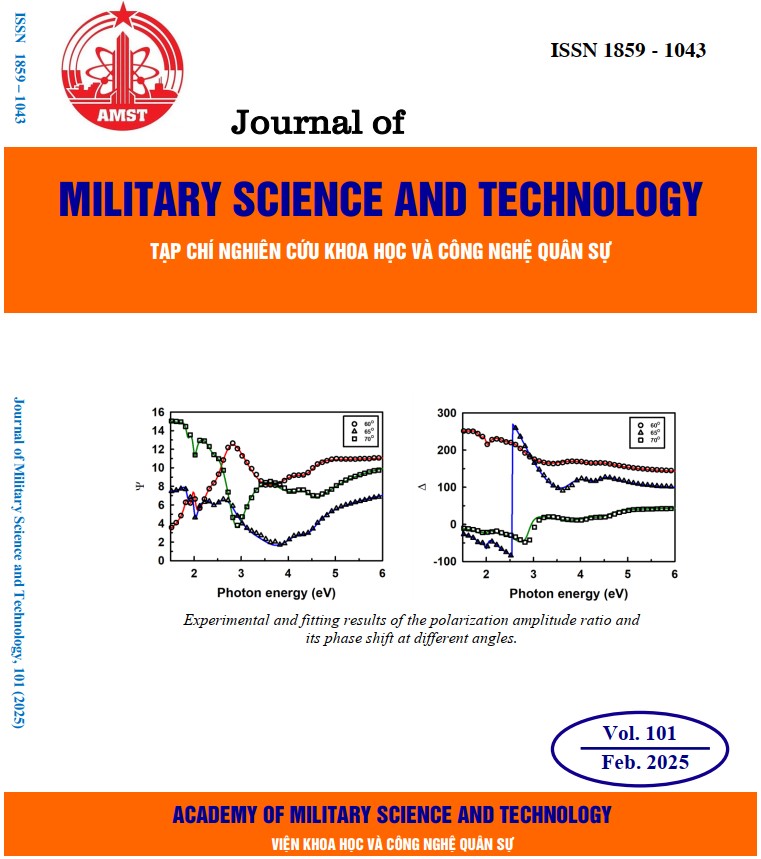Developing new model order reduction algorithms to enhance the efficiency of large-scale electrical and electronic circuit simulation: Mixed Balanced Truncation and Riccati–Lyapunov Mixed Balanced Truncation
528 viewsDOI:
https://doi.org/10.54939/1859-1043.j.mst.101.2025.13-22Keywords:
Model reduction; Balanced truncation; Orthogonal balanced truncation; Mixed balanced truncation; Mixed Riccati-Lyapunov balancing truncation; Large circuits.Abstract
This paper investigates model order reduction (MOR) techniques for simulating large-scale electrical and electronic systems, aiming to reduce computational cost and optimize performance while preserving essential physical properties. In particular, two novel reduction algorithms—Mixed Balanced Truncation (MBT) and Riccati–Lyapunov Mixed Balanced Truncation (MRLBT)—are developed to improve efficiency compared to standard Balanced Truncation (BT) and Positive Real Balanced Truncation (PRBT) methods. Both the MBT and MRLBT algorithms maintain the stability and passivity of the original system. The paper details the implementation steps of the algorithms and compares their performance on RLC circuits through simulations that include error analysis as well as time- and frequency-domain response evaluations. The results indicate that MBT strikes a balance between accuracy and computational cost, with reduction errors positioned between those of BT and PRBT, while MRLBT achieves the best overall performance and meets the model reduction requirements most effectively among the four methods considered.
References
[1]. P. Benner, S. Grivet-Talocia, A. Quarteroni, G. Rozza, W. Schilders, and L. M. Silveira, “System-and data-driven methods and algorithms”. De Gruyter, (2021). DOI: https://doi.org/10.1515/9783110498967
[2]. R. W. Freund, “Electronic Circuit Simulation and the Development of New Krylov-Subspace Methods,” in Novel Mathematics Inspired by Industrial Challenges, Springer, pp. 29–55, (2022). DOI: https://doi.org/10.1007/978-3-030-96173-2_2
[3]. S.-M. Liu, L.-J. Jiang, and P. Li, “A Fast AWE-Augmented Wideband Discontinuous Galerkin Frequency-Domain Method in Solving Electromagnetic Wave Equations,” in 2022 IEEE International Symposium on Antennas and Propagation and USNC-URSI Radio Science Meeting (AP-S/URSI), IEEE, pp. 1352–1353, (2022). DOI: https://doi.org/10.1109/AP-S/USNC-URSI47032.2022.9886356
[4]. A. Bhattacharya, P. Nandy, P. P. Nath, and H. Sahu, “On Krylov complexity in open systems: an approach via bi-Lanczos algorithm,” Journal of High Energy Physics, vol. 2023, no. 12, pp. 1–30, (2023). DOI: https://doi.org/10.1007/JHEP12(2023)066
[5]. A. K. Prajapati and R. Prasad, “Model reduction using the balanced truncation method and the Padé approximation method,” IETE Technical Review, vol. 39, no. 2, pp. 257–269, (2022). DOI: https://doi.org/10.1080/02564602.2020.1842257
[6]. M. A. Khattak, D. Romano, G. Antonini, and F. Ferranti, “Efficient Frequency and Time-Domain Simulations of Delayed PEEC Models With Proper Orthogonal Decomposition Techniques,” IEEE Access, (2023). DOI: https://doi.org/10.1109/ACCESS.2023.3347193
[7]. G. Wang, J. Yang, and J. Jiao, “Voltage correlation-based principal component analysis method for short circuit fault diagnosis of series battery pack,” IEEE Transactions on Industrial Electronics, vol. 70, no. 9, pp. 9025–9034, (2022). DOI: https://doi.org/10.1109/TIE.2022.3210588
[8]. H. R. Ali, L. P. Kunjumuhammed, B. C. Pal, A. G. Adamczyk, and K. Vershinin, “Model order reduction of wind farms: Linear approach,” IEEE Trans Sustain Energy, vol. 10, no. 3, pp. 1194–1205, (2018). DOI: https://doi.org/10.1109/TSTE.2018.2863569
[9]. P. Vuillemin, A. Maillard, and C. Poussot-Vassal, “Optimal modal truncation,” Syst Control Lett, vol. 156, p. 105011, (2021). DOI: https://doi.org/10.1016/j.sysconle.2021.105011
[10]. F. D. Freitas, J. Rommes, and N. Martins, “Developments in the Computation of Reduced Order Models with the Use of Dominant Spectral Zeros,” in Realization and Model Reduction of Dynamical Systems: A Festschrift in Honor of the 70th Birthday of Thanos Antoulas, Springer, pp. 215–233, (2022). DOI: https://doi.org/10.1007/978-3-030-95157-3_12
[11]. B. Moore, “Principal component analysis in linear systems: Controllability, observability, and model reduction,” IEEE Trans Automat Contr, vol. 26, no. 1, pp. 17–32, (1981). DOI: https://doi.org/10.1109/TAC.1981.1102568
[12]. A. C. Antoulas, Approximation of large-scale dynamical systems. SIAM, (2005). DOI: https://doi.org/10.1137/1.9780898718713
[13]. S. K. Suman and A. Kumar, “Linear system of order reduction using a modified balanced truncation method,” Circuits Syst Signal Process, vol. 40, pp. 2741–2762, (2021). DOI: https://doi.org/10.1007/s00034-020-01596-3
[14]. S. Tan and L. He, “Advanced model order reduction techniques in VLSI design”. Cambridge University Press, (2007). DOI: https://doi.org/10.1017/CBO9780511541117
[15]. T. Reis and T. Stykel, “Positive real and bounded real balancing for model reduction of descriptor systems,” Int J Control, vol. 83, no. 1, pp. 74–88, (2010). DOI: https://doi.org/10.1080/00207170903100214
[16]. P. Benner and T. Stykel, “Model order reduction for differential-algebraic equations: a survey”. Springer, (2017). DOI: https://doi.org/10.1007/978-3-319-46618-7_3
[17]. Z. Salehi, P. Karimaghaee, and M.-H. Khooban, “A new passivity preserving model order reduction method: conic positive real balanced truncation method,” IEEE Trans Syst Man Cybern Syst, vol. 52, no. 5, pp. 2945–2953, (2021). DOI: https://doi.org/10.1109/TSMC.2021.3057957
[18]. K. Unneland, P. Van Dooren, and O. Egeland, “A novel scheme for positive real balanced truncation,” in 2007 American Control Conference, IEEE, pp. 947–952, (2007).
[19]. K. Unneland, P. Van Dooren, and O. Egeland, “New schemes for positive real truncation”, (2007). DOI: https://doi.org/10.1109/ACC.2007.4282863
[20]. J. Phillips, L. Daniel, and L. M. Silveira, “Guaranteed passive balancing transformations for model order reduction,” in Proceedings of the 39th Annual Design Automation Conference, pp. 52–57, (2002). DOI: https://doi.org/10.1145/513918.513933
[21]. U. Zulfiqar, W. Tariq, L. Li, and M. Liaquat, “A passivity-preserving frequency-weighted model order reduction technique,” IEEE Transactions on Circuits and Systems II: Express Briefs, vol. 64, no. 11, pp. 1327–1331, (2017). DOI: https://doi.org/10.1109/TCSII.2017.2685440
[22]. A. C. Antoulas et al., “Model order reduction: methods, concepts and properties,” Coupled multiscale simulation and optimization in nanoelectronics, pp. 159–265, (2015). DOI: https://doi.org/10.1007/978-3-662-46672-8_4







